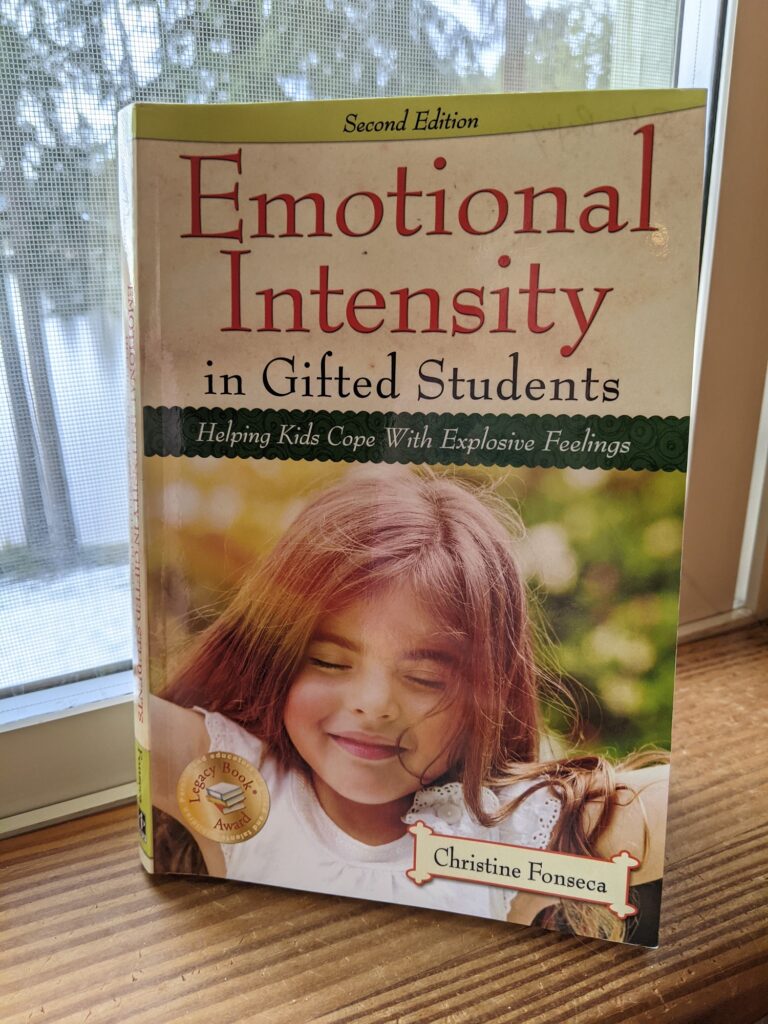
“When you struggle, when you feel like you have failed… remember, there is no way you can fail… if you are continuously trying to help your child move in the direction of mastery and acceptance of [their] emotional intensity” (p. 197).
In her book Emotional Intensity in Gifted Students: Helping Kids Cope With Explosive Feelings (2016), Christine Fonseca offers a powerful resource to parents and teachers seeking guidance on how to support gifted children through their emotional intensities.
In Part One (What is Really Means to Be Gifted), Fonseca defines emotional intensity as “strong and intense emotional reactions to various situations”, often characterized by “frequent wavering between happiness and anxiety” (p. 28). While emotional intensity can manifest as “explosive outbursts, crying jags, paralyzing anxiety, or fear”, it also shows up as “giddiness, highly frenetic energy, laughter, and general happiness.”
Fonseca points out that “another aspect of emotional intensity lies in a strong affective memory” – “not just the events of a situation, but the feelings associated with the event as well.” Indeed, “some of the negative aspects of emotional intensity . . . include excessive fear in seemingly normal situations, highly critical self-talk, extreme guilt and shame related to perceived imperfections, and the feeling of being out of control” (p. 29). These can have serious ramifications on a person’s life, and are a powerful reminder of why it’s so important to help kids learn to manage their strong emotions effectively. (I sure wish I’d had more of this support earlier on in my life . . . )
Fonseca also discusses temperament (introversion and extroversion), gender, and twice-exceptionality as variables that can impact how we manifest and deal with emotional intensity.
(What’s missing from this section is an emphasis on how cultural diversity and race can impact the ways in which gifted kids’ emotional intensity is expressed and perceived by others. Emotionally ‘explosive’ behavior by kids from communities of color, for instance, can place them especially at risk in school. I’ll be addressing other resources available on this topic in future posts.)
In Part Two (Great Information, But Now What?) Fonseca turns to specific strategies for supporting emotionally intense kids, starting with Building a Solid Foundation (Ch. 6). This involves “creating a space that allows the child to develop the positive aspects of giftedness while also mediating the negative aspects” (p. 59). Steps include: 1) providing clear expectations and consequences for behavior, 2) setting appropriate boundaries, and 3) offering authentic opportunities for involvement in the household (or classroom). Fonseca recommends holding family (or classroom) meetings, doing regular household/classroom “inventories”, and maintaining continuous communication between school and home.
In Chapter 7, Fonseca directly addresses “Working With the Explosion”, noting that “explosions are not always aggressive outbursts of behavior” but instead can sometimes be “more passive, subtle expressions of protest” such as “anxious and sad behavior” (p. 79). (This is a really important and powerful distinction; it makes me wonder whether “explosive” is the most appropriate term to use, given that “implosive” seems equally relevant.) What these reactions have in common, however, is children expressing their (natural) desire for “power and control, or autonomy, in their lives”.
Fonseca points out that the best strategy for managing explosive outbursts is to prevent or defuse them by recognizing warning signs of escalation – including “an agitated tone of voice, a change in body language, or tears welling in the eyes” (p. 81) – and helping kids to recognize these in themselves. She suggests “developing an emotional language” to use with your child (working collaboratively to identify key phrases and words), and providing kids with a variety of techniques to calm their emotions.
During the crisis, Fonseca recommends disengaging “from the emotional aspect of the crisis”, ensuring “everyone is safe”, providing a “cooling off” period, and remembering that “some things are best ignored” (p. 96). After the crisis (during what Fonseca refers to as the “cleaning up” stage), it’s important to remember that “all explosions are teachable moments”, that we can “debrief and strategize” with our kids, and that consequences (either natural or contrived) should occur.
In Part Three (Being Your Child’s Coach: Specific Strategies), Fonseca walks us through various “explosive” scenarios with kids and helps us think about reframing our language. She discusses what it means to be a coach for our kids (including effective communication, effective facilitation, and being a source of inspiration), and then addresses a variety of different challenges related to Relationships, Performance, and Behavior. Fonseca is compassionate and generous in naming the various ways we may be tempted to handle a situation with our child, while also providing and explaining reasonable alternatives to try next time. What her reframes all have in common is aiming towards the goal of helping “your child learn to master his own emotions” (p. 197).
Fonseca closes her book by reminding us:
“Raising gifted children is a difficult job. More often than not, we feel overwhelmed – both because of the intensity we are confronted with every day and our own guilt when we are unsuccessful in our dealings with our children” (p. 197).
This most definitely rings true. Each time I support one of my kids through an emotionally intense situation, I end up feeling completely drained myself, like I need the rest of the day to recover. With that said, this is obviously some of the most important work we can do with and for our kids – and knowing that our actions and words can help set them up for future success and autonomy makes the commitment more than worthwhile.
I’ll be returning to concepts from Fonseca’s book in future blog posts, relating them back to specific (challenging) moments from my own childhood as well as current parenting (and partnering!) scenarios. Stay tuned!
References:
Fonseca, C. (2016). Emotional Intensity in Gifted Students: Helping Kids Cope With Explosive Feelings (2nd Edition). Prufrock Press Inc.
Copyright © 2021 by HalfoftheTruth.org. Please feel free to share with attribution.
